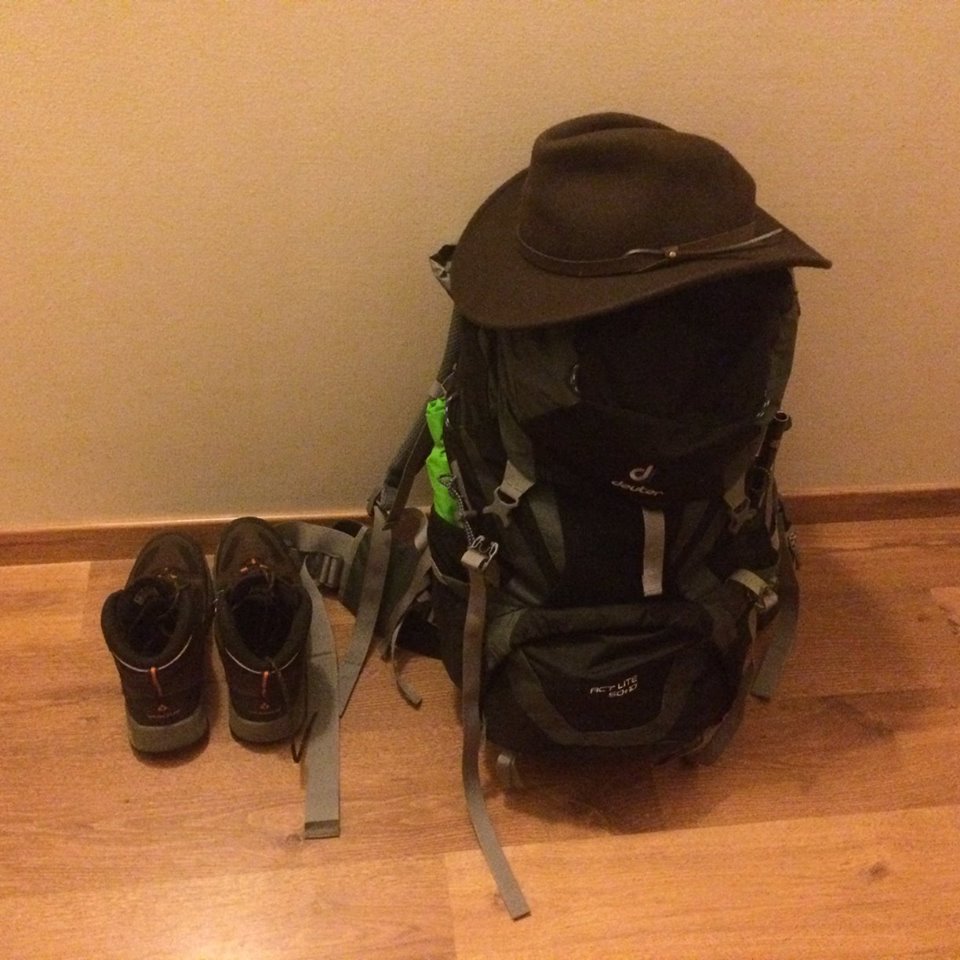Camino Tips: Before you leave home


In Tuesday’s post, I shared a list of the equipment I took with me on the Camino. In today’s post I would like to share my suggestions for things which you can do in the time leading up to the Camino which will stand you in good stead for your trip…
1. Train!
In the weeks and months leading up to the Camino, make sure you do some training. How much training you do will very much depend upon your personal level of fitness. I only did a couple of weeks of preparation, but I would have probably benefited from a week or two more.
When you train, I would suggest walking for at least two or three hours at a time. One mistake I made in my own training was not to walk up and down enough hills. I paid for this mistake while on the Camino, particularly on the first day when I had to tackle the Pyrenees…
2. Pack light!
This is probably the best piece of advice out there for anyone planning to walk the Camino. There will be the temptation to over pack your bag, particularly with some of the comforts of life. Resist this inclination! I constantly met pilgrims who were abandoning equipment or mailing it back home. Everything you pack, you will be carrying on your back for at least thirty days. As you put each item in the bag, ask yourself, “Do I really need this?”
I would also suggest purchasing lightweight versions of the equipment. Although your gear might be a little more expensive, it will also be a little lighter. Every ounce matters!
3. Choose your own rock!
There is a tradition of taking a rock with you on the Camino. This rock is symbolic of your burdens and your reason/intention behind doing the pilgrimage. It’s typically not very big, nothing more than a pebble…

My delightful Seattle friends chose my rock for me…I suggest you avoid this by choosing your own early!
4. Buy quick-drying everything
Getting wet clothes dry was a consistent challenge on the Camino. Make life easier for yourself by buying clothes that aren’t going to retain the wetness.
5. Have distinctive clothes
You will be using communal washing machines and clothes lines. Therefore make sure your clothes (underwear and socks in particular) are as distinctive as possible. I managed to leave a pair of underpants at a hostel because most pairs of black underwear looks the same at 6am. My green pair, on the other hand, was never in any danger of being overlooked!
6. Use a Light sleeping bag
As long as you are walking the Camino during the warmer months, you would do well to bring only a very light sleeping bag. This will also help with the weight of your pack. If you get a little chilly, you can just wear more clothes at night.
Over the course of the Camino, the temperature in the dormitories did vary, although it was typically good. Even when it was a little cold outside, the large numbers of bodies packed into a small room often brought the temperature back up.
7. Bring Plastic pegs (marked)
Many of the hostels have lines for drying clothes, but they typically do not provide any means of securing your clothes to those lines. As a result, I was glad to have brought some clothes pegs with me.
My clothes pegs were wooden, which unfortunately meant that they got a little mouldy during my final week, so I had to throw them away. Because of this, I would recommend bringing plastic pegs which will be resistant to mold. I would also suggest identifying them in some way, such as by painting their tips with some distinctive nail polish.
8. Pack a headlamp
You don’t want to be walking in the dark, either in the evening or first thing in the morning. It’s dangerous and it’s very easy to miss a Camino sign in the half-light. Avoid this by packing a good headlamp in an easily accessible part of your pack. Begin the Camino with fresh batteries to make sure it doesn’t die suddenly, leaving you stranded in darkness, and forcing you to go shopping for replacements later.
9. Pack a pillow
This isn’t strictly necessary, but something I found helpful. I took a blow-up pillow with me on the Camino, even though every hostel provided a pillow. I ended-up using my blow-up pillow for my head and the superfluous hostel pillow to elevate my feet while I was sleeping, which worked wonders in relieving my tired knees and feet.
10. Waterproof EVERYTHING
There’s nothing worse than having wet clothes and equipment. At a bare minimum, you will need a waterproof cover for your backpack. However, you would do well to add other layers of waterproofing.
I had all of my kit inside my backpack wrapped in a number of plastic bags. If you do this, I recommend using either transparent plastic bags or those of varying colours, since this will make packing and organizing considerably easier. Also, if you don’t want to annoy people too much in the mornings, choose plastic bags which don’t make too much of a crunching noise!
If you begin your Camino in St. Jean, the Pilgrim Office will give you a sealable, waterproof bag for your pilgrim passport (“credential”). I would suggest also storing your international passport and other paperwork in this bag too.
11. Check your mobile/cell phone carrier
I met quite a lot of pilgrims who had issues with their phones. I met one pilgrim, for example, whose phone didn’t work at all in Spain. Other pilgrims had abysmal data rates, forcing them to rely upon the wifi in the hostels, which often wasn’t that great. I found T-Mobile to be the best US cell phone provider in terms of coverage and data rates.
12. Watch “The Way”
Not only is this a very inspiring movie, pilgrims on the Camino will be referencing this movie constantly! So, if you don’t want to feel left out, watch it before you leave:
You are now ready to begin! It’s time to travel to St. Jean Pied-de-Port and begin your journey…
Equipment | Before you leave home | On the road | Staying in Hostels
Index
